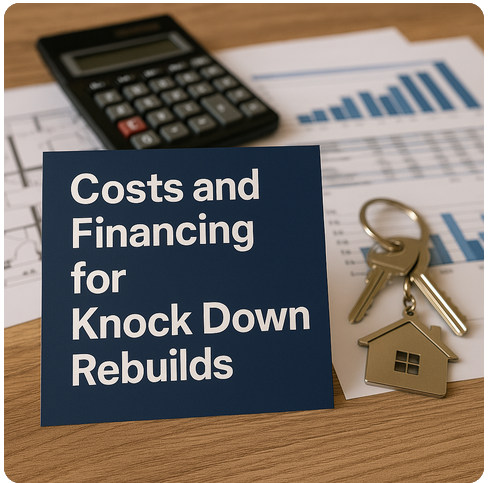Costs and Financing for Knock Down Rebuilds: What You Need to Know
Thinking about knocking down your old home and starting fresh? A knock down rebuild can be a smart, long-term move — but understanding the costs and how to finance the journey is just as important as choosing your design.

At Ward Builders, we know how vital it is to plan your budget from the ground up. So here’s a practical guide to the typical costs involved and the financing options available to help make your rebuild a reality.
What Does a Knock Down Rebuild Really Cost?
Every project is different, but here’s a breakdown of the main cost categories you’ll need to consider. These can vary based on your land, council requirements, design, and finishes.
Typical Cost Breakdown
| Cost Item | Estimated Range | Notes |
|---|---|---|
| Demolition | $15,000 – $40,000 | Includes removal of the existing structure, asbestos (if present), and site clearing |
| Design & Planning | $10,000 – $25,000 | Includes architectural plans, site surveys, soil testing, engineering, BASIX/NCC compliance |
| Council Fees & Permits | $2,000 – $8,000 | Covers demolition permit, building permit, town planning if applicable |
| New Home Construction | $2,500 – $4,000+ per sqm | Depends on the builder, design complexity, inclusions, and finishes |
| Site Preparation | Varies | Retaining walls, drainage, difficult access, or sloping sites may increase cost |
| Temporary Accommodation | $400 – $800/week | Allow 6–12 months depending on project timeline and rental availability |
| Driveway & Landscaping | $10,000 – $30,000+ | Often not included in base build contracts |
| Contingency Fund | 10% – 15% of total build cost | To cover variations, delays, or unexpected expenses |
Financing Your Knock Down Rebuild
Financing a knock down rebuild is different from a standard mortgage or house purchase. You’ll usually need a construction loan — a specialised loan structured around progressive payments as the build progresses.
Types of Loans to Consider
| Loan Type | Key Features |
|---|---|
| Construction Loan | Funds released in stages (“drawdowns”) as each milestone of your build is completed. Interest is usually paid only on the funds used so far. |
| Refinance & Rebuild | Use equity in your current home to finance the new build (often paired with demolition costs). |
| Knock Down Rebuild Packages | Some lenders offer bundled products tailored to KDR projects. Look for flexible repayment options and staged release terms. |
💡 Tip: Some lenders allow interest-only payments during the build, easing pressure while you’re paying rent and funding construction at the same time.
What Do Lenders Look For?
When applying for finance, your bank will typically assess:
- ✅ Land value and equity
- ✅ Proposed construction cost and timeline
- ✅ Your income and serviceability
- ✅ Builder’s licence and fixed-price contract
- ✅ Approved plans and permits
A signed building contract with a reputable, licensed builder like Ward Builders will help speed up approval and provide confidence to your lender.
Budgeting Tips
Over the years, we’ve helped many families through this process. Here are a few insights that might help you plan better:
- Know what’s included – Check the fine print in your builder’s inclusions list. Things like driveways, fencing, or internal upgrades are often additional.
- Account for demolition and prep costs early – These can add up fast, especially if your block is sloped or access is tricky.
- Talk to your lender before finalising plans – Avoid design changes later that affect your loan approval or delay progress.
- Set aside a buffer – Weather delays, supply shortages, or unexpected challenges can impact timelines and costs.
Financing With Confidence
The financial side of a knock down rebuild can feel daunting — but with good planning and the right builder by your side, it becomes far more manageable. At Ward Builders, we help clients connect with trusted finance partners and provide fixed-price contracts that support your loan process.
Our team will walk you through the full breakdown of what’s included and where to expect extras, so you can build with confidence — no budget blowouts, no nasty surprises.
Final Word
A knock down rebuild is a big step, but it’s also a rewarding one. With the right financial setup and a clear plan, you can go from worn-out weatherboard to dream home — all without leaving your block.
If you’re ready to explore what’s possible, get in touch with a trusted builder and a knowledgeable finance broker early. It’s the first step toward building a better future, right where you are.
Read more about Knock Down Rebuilds:
- Understanding Knock Down Rebuilds
- Finding the Right Location for Your Knock Down Rebuild
- Designing Your Dream Home with a Knock Down Rebuild
- Working with a Knock Down Rebuild Builder
- Permits and Regulations for Knock Down Rebuilds
- Demolition and Site Preparation for Knock Down Rebuilds
- Building Materials and Technology for Knock Down Rebuilds
- Interior Design and Finishing Touches for Knock Down Rebuilds
- Moving into Your New Home and Future Maintenance









